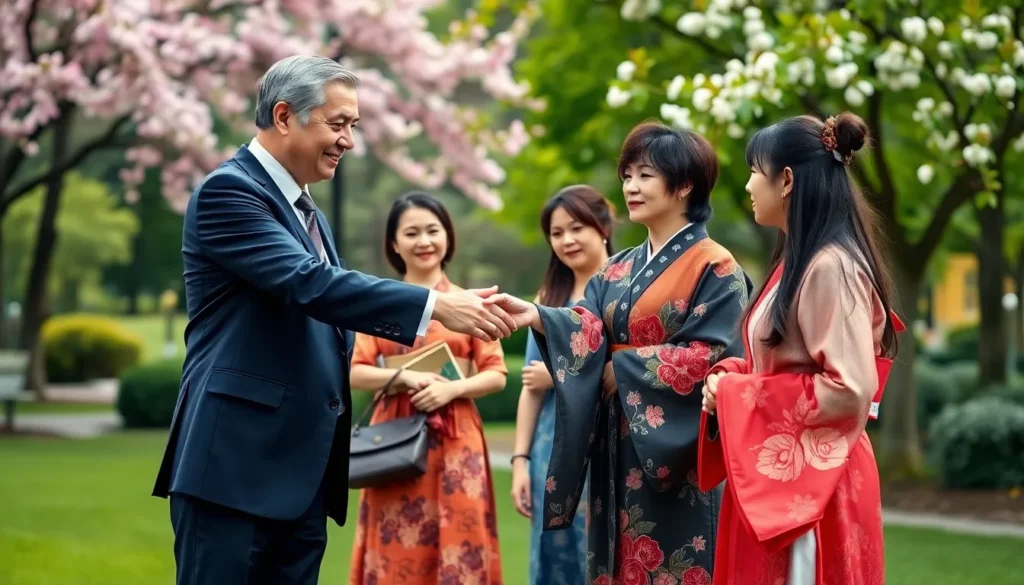Table of Contents
ToggleNavigating social etiquette can feel like stepping into a minefield, especially when crossing borders. What’s polite in one country might raise eyebrows in another. Ever tried to greet someone in Japan with a hearty handshake only to be met with a deep bow? Awkward, right? Understanding these cultural nuances isn’t just about avoiding faux pas; it’s your ticket to making friends and influencing people—without the cringe.
Social Etiquette Around The World
Social etiquette varies widely across the globe, reflecting unique cultural values and traditions. In France, greetings often include a light kiss on the cheek, typically alternating sides, while in countries like the United States, a firm handshake predominates. Different gestures convey different meanings; for instance, in some Middle Eastern cultures, physical contact between opposite sexes, such as handshakes, may not be acceptable.
Dining etiquette also differs. In China, it’s polite to leave some food on the plate to signal fullness, whereas in many Western cultures, finishing all food often celebrates hospitality. In Brazil, being late to social events is generally forgiven, as punctuality holds less importance, unlike in Germany, where arriving late may be seen as disrespectful.
Gift-giving customs can also present challenges. In Japan, gifts are typically wrapped beautifully, and the presentation signifies respect. In contrast, in some Western countries, the thought behind the gift matters more than its wrapping. Certain gifts, such as knives, may be considered unlucky in specific cultures, including Chinese tradition.
Understanding these social norms requires awareness and sensitivity. People traveling internationally or engaging with diverse communities benefit greatly from knowing the local customs. This knowledge helps foster respectful interactions and enriches personal relationships. Adapting behaviors to suit local practices can prevent misunderstandings and cultivate goodwill, making it essential for anyone navigating various cultures.
The Importance Of Social Etiquette

Social etiquette shapes interactions across cultures, fostering understanding and harmony. Being aware of cultural differences helps navigate social situations effectively.
Understanding Cultural Differences
Recognizing cultural differences is vital in today’s global society. Customs such as greetings, dining habits, and communication styles vary greatly. A handshake symbolizes greeting in many Western cultures, while a bow holds significance in Japan. Understanding these nuances prevents awkward miscommunications and demonstrates respect for local traditions. For instance, in some Middle Eastern cultures, a warm embrace is customary, whereas personal space is valued in Nordic countries. Such variations highlight the importance of research and adaptation to different social norms.
Building Respect And Trust
Respect and trust form the foundation of successful interpersonal relationships. Observing local etiquette establishes credibility and shows a willingness to connect. For example, engaging in small talk before discussing business in some cultures reinforces trust. Being punctual reflects respect in countries like Germany, while flexibility in timing is welcomed in Latin America. Simple gestures, such as listening actively and acknowledging others’ perspectives, cultivate mutual respect. Ultimately, embracing social etiquette enhances collaboration and fosters meaningful connections across diverse communities.
Common Etiquette Practices
Understanding etiquette customs helps navigate global social landscapes. Recognizing the significance of greetings and dining behavior can enhance interactions.
Greetings And Introductions
Greeting customs vary significantly across cultures. In Western countries, a firm handshake often conveys confidence. In contrast, many Asian cultures value a slight bow as a sign of respect. Eye contact is essential in some regions, while avoiding it is customary in others, like Japan, to show humility. Personal space preferences also differ; Latin Americans tend to engage in closer proximity compared to those from Nordic countries. Being mindful of these variations fosters respectful introductions and builds rapport.
Dining Etiquette
Dining practices significantly vary worldwide. In China, leaving food on the plate signals fullness and satisfaction. Conversely, finishing every bite is polite in many Western cultures, indicating appreciation for the meal. Table manners also differ; Western diners often keep hands on the table, while Middle Eastern customs prefer hands off the table. It’s vital to follow local customs, as they reflect cultural values. For example, using chopsticks correctly in Asian countries shows respect for tradition. Adhering to these dining practices not only prevents misunderstandings but also promotes positive dining experiences.
Unique Etiquette Norms
Social etiquette varies significantly around the globe. Understanding these differences aids in fostering respectful interactions.
East Asian Countries
In East Asian countries, greeting customs often prioritize subtlety and respect. A bow symbolizes acknowledgment in Japan, reflecting humility and respect. Koreans might combine a bow with a handshake, showing warmth in professional situations. Dining habits are equally nuanced; for instance, leaving food on the plate in China indicates satisfaction with the meal. In South Korea, using two hands when receiving or giving items demonstrates respect. Elders receive the greatest regard, as younger individuals often defer to their opinions.
Western Nations
Western nations tend to emphasize directness and openness in social interactions. A firm handshake serves as a common greeting, projecting confidence and warmth. Eye contact is generally expected, signifying trust and engagement. Dining etiquette focuses on finishing meals, as it communicates appreciation toward the host. In social settings, engaging in small talk is standard practice, with topics like weather or local events fostering connections. Differences emerge by country; for example, in the United States, maintaining personal space is crucial, whereas some cultures, like in Italy, enjoy closer proximity when conversing.
Tips For Practicing Good Etiquette
Practicing good etiquette fosters understanding and respect in social interactions. Several strategies help navigate social norms effectively.
Observing And Adapting
Observing behaviors in social settings offers valuable insights. Pay attention to how people greet each other, how they show respect, and their general demeanor. Adapting behavior to mirror local customs enhances connection. For example, adopting the bow in Japan can show respect and comprehension of cultural values. Noticing nuances like the distance maintained while speaking can further aid in fitting in. When in doubt, individuals can observe attendees at social gatherings or business meetings to gauge appropriate conduct.
Learning Local Customs
Learning local customs before traveling prepares individuals for varied interactions. Researching specific etiquettes, such as gift-giving practices or dining rules, provides a foundation. Knowing that leaving food on the plate signals satisfaction in China contrasts sharply with Western norms where finishing food shows appreciation. Engaging with locals helps clarify customs and build friendships. Participating in cultural events or joining conversations can deepen understanding. Utilizing available resources, like guides or online forums, enhances awareness of essential etiquette practices.
Navigating social etiquette around the world is essential for fostering meaningful connections. By embracing cultural differences in greetings dining practices and communication styles individuals can enhance their interactions and avoid potential misunderstandings.
Respecting local customs not only builds credibility but also demonstrates a genuine interest in connecting with others. As the world becomes increasingly interconnected understanding these nuances will play a pivotal role in promoting harmony and mutual respect across diverse communities.
Ultimately practicing good etiquette is not just about following rules; it’s about creating positive experiences that enrich relationships and deepen cultural appreciation.







